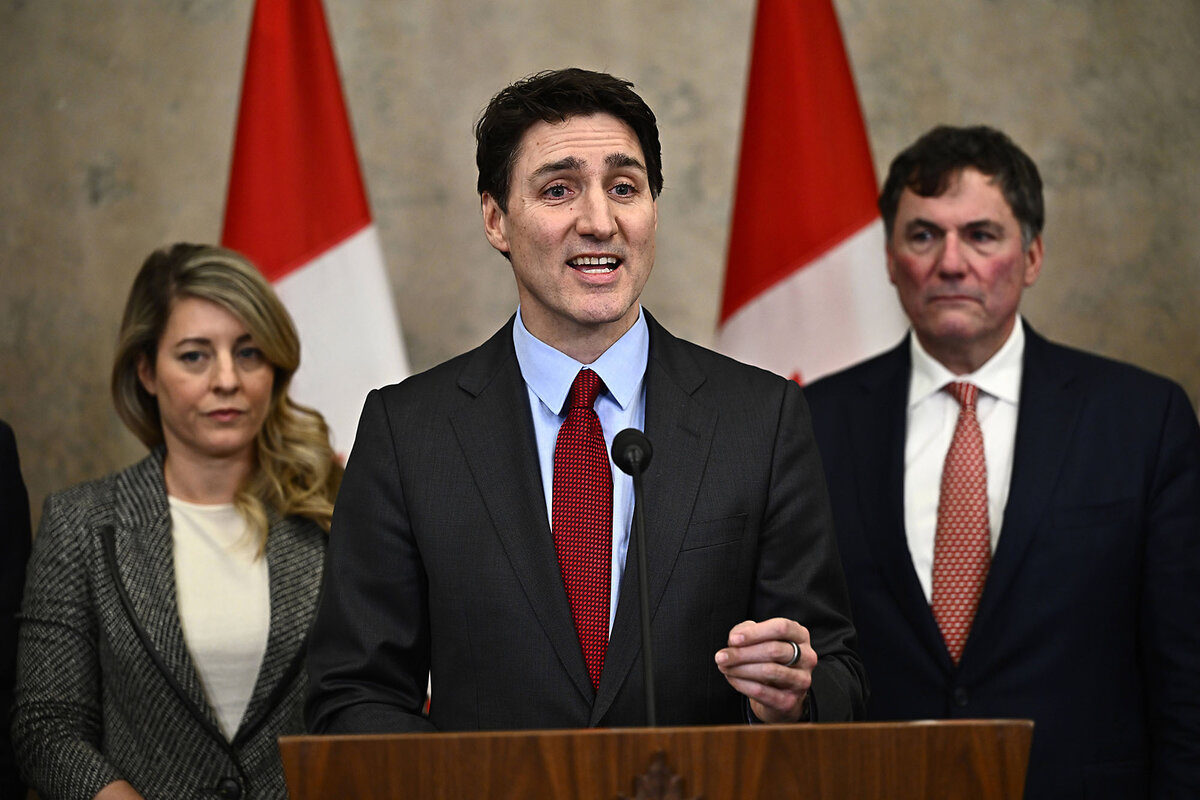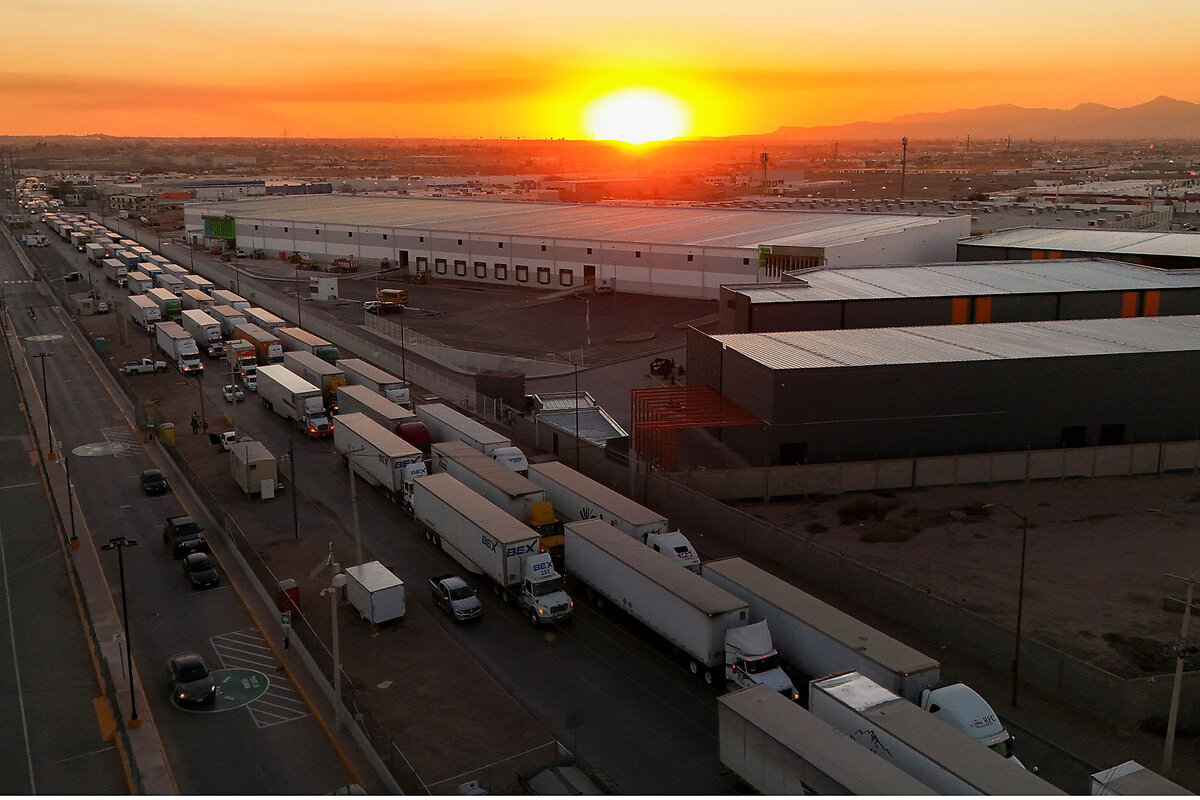With tariffs, Trump wields leverage and sows disruption like no other US president
Loading...
| Washington
In short order, President Donald Trump has proved every bit the disrupter he pledged to be in a second term.
He has launched a trade war with the United States’ neighbors and largest trading partners – warning Americans they may feel “some pain,” but if so, it’s “worth the price.” He has allowed ally Elon Musk and his team access to the Treasury Department’s multi-trillion-dollar payment system. He got Venezuela to release U.S. hostages and receive deported migrants, while revoking the protected status of more than 300,000 Venezuelans in the U.S.
And that’s all since Friday. It’s a new day in Washington, as Mr. Trump aggressively pursues an “America First” agenda and smaller government during a second term that’s barely two weeks old.
Why We Wrote This
President Donald Trump’s new tariffs against Canada, Mexico, and China are sending shock waves into global markets and dismaying allies. Economists warn they could boost U.S. inflation.
His three executive orders Feb. 1 imposing tariffs on imports from Mexico, Canada, and China, while long promised, shocked the world with their scope and potential economic disruption. The move shows the president embracing the role of economic risk-taker, despite the uncertainties that creates for the global economy, for U.S. leadership, and for his own popularity. The goal, says the White House fact sheet on the new orders, is to bring down the perennially massive U.S. trade deficit, halt illegal immigration via both the southern and northern U.S. borders, and stop fentanyl and other drugs from flowing into the country. China is a major producer and exporter of precursor chemicals used to make the deadly synthetic opioid.
But Mr. Trump’s tariffs pose dangers. Mexico’s already slowing economy could go into recession, experts say. Economic growth in Canada, too, could plunge into negative territory. In the U.S., the move could boost inflation, already above the Federal Reserve’s 2% target, as the cost of tariffs is often passed along to consumers. Bringing down inflation was a top Trump campaign promise.
Under the U.S.-Mexico-Canada Agreement, or USMCA – a free-trade deal Mr. Trump negotiated during his first term – the three countries’ economies are deeply intertwined, particularly in the agricultural, automotive, and energy industries. But beginning Tuesday, Mexico and Canada both face tariffs of 25% on exports to the U.S., except for a 10% tariff on Canadian energy. China, the world’s second largest economy, faces new U.S. tariffs of 10% – in addition to existing tariffs dating back to Mr. Trump’s first term that are as high as 50%, and that caused hardship for American farmers who required government bailouts.
Canada retaliates; Trump wields leverage
Canada, Mexico, and China are quickly retaliating or have vowed to. And in denouncing the U.S. move, China declared that “fentanyl is America’s problem.”
Canada, in particular, has reacted with hurt and shock. Unlike the Mexico-China connection on fentanyl, a focus of genuine U.S. public concern, policymakers are hard-put to identify what Canada has done “wrong.”
“We have fought and died alongside you during your darkest hours,” Canadian Prime Minister Justin Trudeau said Saturday. “We’ve built the most successful economic, military, and security partnership the world has ever seen.... We’re always there, standing with you.”
Mr. Trudeau announced retaliatory tariffs of 25% against the U.S. on food, clothing, and household items.
But Mr. Trump, as president of the richest and most powerful nation on earth, has the most leverage, and he knows it. And he alleges that allies including Canada have taken advantage of the U.S. with “unfair” trade deficits and by failing to spend enough on defense.
“Tariffs are a powerful, proven source of leverage for protecting the national interest,” the White House stated in its fact sheet on the executive orders Mr. Trump signed Saturday from his Mar-a-Lago estate in Florida.
It’s not clear how far the president is willing to go. Last week, when he threatened tariffs on Colombia after it refused to accept flights of deported migrants from the U.S., the South American nation quickly backed down.
But U.S. dealings with its North American neighbors, and with China, may be another matter.
The U.S. and key trading partners could face “an endless game of chicken” for the next four years, says Raymond Robertson, an expert on international trade at Texas A&M University.
“The bet is that we’re both going to be damaged if we actually follow through,” Professor Robertson says. “But we’re expecting their perception of the damage to be bigger, so we expect them to flinch first.”
And Mr. Trump isn’t finished issuing threats. On Friday, he promised new tariffs against Europe, accusing the 27-nation European Union of treating the U.S. “so terribly.” He’s been making noise on social media about EU tariffs for months, saying that he wants Europe to buy more U.S. products, including energy, in an effort to bring down the U.S. trade deficit.
On Sunday talk shows, experts and partisans had plenty to say on Mr. Trump’s tariff threats.
“I don’t think these other countries are likely to accept meaningful changes in policy,” said Larry Summers, former Treasury secretary under President Bill Clinton, on CNN. “Think about what giving in to a bully does. It invites more bullying.”
Speaking on “Fox News Sunday,” Republican Sen. Lindsey Graham of South Carolina defended Mr. Trump’s tariffs. “If you want tariffs to go away, Mexico and China, stop poisoning Americans,” he said.
Later on Sunday, a reporter asked Mr. Trump how Canada and Mexico could get the tariffs lifted. ”They have to balance out their trade, number one,” he said. “They’ve got to stop people from pouring into our country. ... And we have to stop fentanyl. And that includes China.”
Musk-led disruption in U.S. agencies
The other weekend drama in Washington centered on Mr. Musk, the ultra-wealthy Trump adviser focused on downsizing government. On Friday, a longtime top civil servant in the Treasury Department, David Lebryk, was forced out after a clash over access to the department’s payment system. Mr. Musk’s team is seen as wanting such access as part of its effort to reduce government spending. At the Office of Personnel Management, where Musk aides have taken charge, career officials have been locked out of agency computer systems, spurring employee protests.
And at the U.S. Agency for International Development (USAID), the website has been offline since Saturday, a likely result of Mr. Trump’s earlier decision to suspend and review foreign aid. Such assistance – which accounts for less than 1% of the $6.8 trillion federal budget – has long been seen as a vehicle for U.S. “soft power” around the globe.
On Saturday, two of the agency’s security officials were forced out by Musk allies, after the USAID officials refused to grant them access to restricted spaces for viewing classified information, according to The Washington Post.
Mr. Musk has called USAID a “criminal organization” and made claims without evidence on his X social media site about agency activities. Supporters of USAID, the world’s largest provider of food aid, have come to the agency’s defense.
“Eliminating USAID – which prevents famines, counters extremism, and creates more markets for U.S. exports – would make the world a more dangerous place for Americans and be a gift to China and Russia,” Sen. Amy Klobuchar, Democrat of Minnesota, said Saturday on X.








